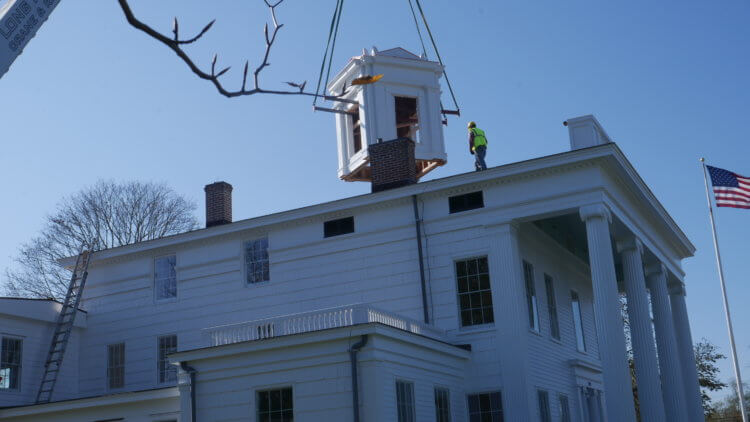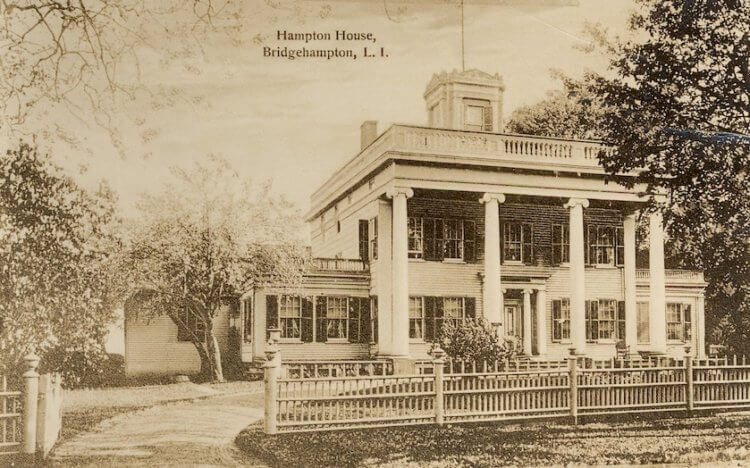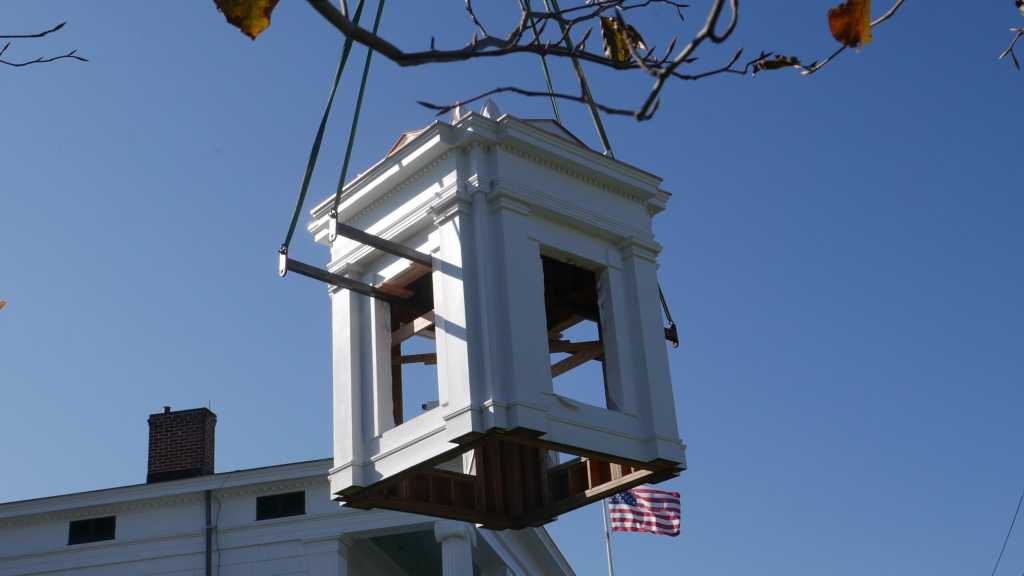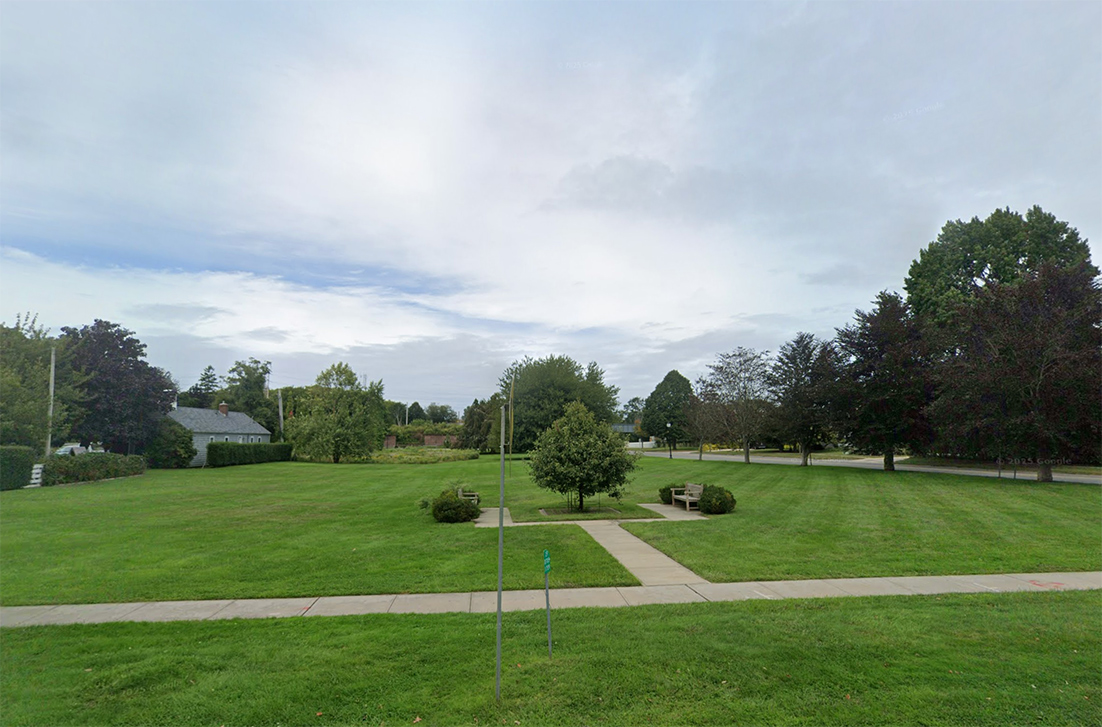An historically accurate replica of the cupola Nathaniel Rogers installed at his Bridgehampton house in 1840 was hoisted atop the restored Greek Revival, which is said to be one of two of the most important surviving examples of such architecture on Long Island.
The restoration of the National Rogers House, a museum under the stewardship of the Bridgehampton Museum, is nearly complete, according to John Eilertsen, the executive director. The 19th century landmark with its grand front porch with four columns and elegant rooftop balustrades, is located on the southeast corner of Montauk Highway and Ocean Road. It was preserved and returned to its former glory over the last decade in a partnership with the Town of Southampton.
“Wooden shutters will go up within two weeks and then the house restoration will be done,” says Eilertsen. “The last remaining thing will be the installation of the replica of the picket fence that was around the house,” which he says should be installed before the end of 2020.
Complete with a pineapple finials on all four corners, the cupola is an exact replica of the one that remained on the house until about the 1940s. Eilertsen says it is a myth that the original cupola blew off during the 1938 Hurricane. “It didn’t. It was removed by the family some years later because they had a persistent roof leak,” in the 1940s, he says.

A large crane hoisted the cupola, about eight square feet and about 12 feet high, to its perch on Wednesday, while museum officials and some town board members looked on. “We’ve always referred to this as the crown jewel,” Eilertsen says. “It was very satisfying and exciting to see it raised up.”
The addition of the decorative rooftop cupola certainly makes the property stand out, which for so long has been a construction site. “The balustrades have also been installed on the third floor. It really changes the look of the house. I drove by it this morning and just thought, ‘Wow that looks great.'”
The house, listed on the National Register of Historic Places and as a landmark in Southampton Town, is one of the few full portico, or temple front, Greek Revival houses to survive on Long Island.
In addition to architecturally important, it is also historically important. Nathaniel Rogers, the famed miniature portraitist, is also an important historical figure. He grew up on the South Fork, then established his career in New York City. His miniatures are displayed in museum collections nationwide, including the Metropolitan Museum of Art.
When he retired, he purchased the house from Abraham Topping Rose, a county judge who built the original 25 by 40 foot, post and beam house around 1824, though portions of the house were discovered to date to the 1790s, Eilertsen says. Rose later built a larger residence across the street, restored and renovated about eight years ago into what is now called the Topping Rose House, an upscale hotel and restaurant (the two buildings are sister houses of sorts).
Rogers remodeled the house in the Greek Revival style, adding rooms, including a the third floor, changing the roof line, and adding exterior porches, including the large portico which defines the front of the home, according to museum research. In 1894, the Hedges and Hopping families purchased the home and turned it into an inn and boarding house known as the Hampton House for the area’s earliest tourists. They added a summer dining room, butler’s pantry, and an apartment for the owners or managers. The hotel closed in 1949 and members of the Hopping family lived there until 2004.

The restoration brought the home’s exterior back to the days of Rogers’ remodel.
The project has been a long road. The town, with the museum’s help, purchased the house in 2003 for $3.5 million, in part with money from the Community Preservation Fund. The restoration work began in 2010. Detailed covenants and preservation standards, requirements from the Secretary of the Interiors in the New York State Office of Historic Preservation that had to be adhered to, along with the bureaucratic process stretched the project out over the next decade.
Eilertsen estimates about $5.6 million has been spent on the restoration. Funding has come from the Town of Southampton, the New York State Office of Parks, Recreation & Historic Preservation, the Helen & Claus Hoie Charitable Foundation and numerous members of the community.
“It was worth doing — expensive, any restoration and preservation project is expensive, but it saves an important part of the hamlet’s history,” Eilertsen says.
The Bridgehampton Museum plans to move its headquarters from the Corwith House, half a mile east to the second floor of the Nathaniel Rogers House. Exhibition space has been set aside on the first floor to showcase the area history in the whaling industry, street and track racing, metal banks and toys, and other subjects. In the replicated south wing, the Helen & Claus Hoie Study Center will allow people to do research using the museum’s extensive archival material.
Meanwhile, the Corwith House will be dedicated toward interpreting Bridgehampton and the surrounding area’s rich agricultural history, and solely house farming exhibits.
Eilertsen is not quite sure when the museum will be able to celebrate the completion of the National Rogers House with all of its supporters due to COVID-19. Several exhibitions will be installed within six weeks, but when the doors will open to the public has not been decided yet. He hopes a soft opening can be held this year and then a grand opening can be held safely in the spring.
“Two hundred and seventy people contributed to the purchase of the house and however many hundreds of people have made donation from $10 to $50,000 towards the restoration process,” Eilertsen says of the community effort to complete the project.
Email tvecsey@danspapers.com with further comments, questions or tips. Follow Behind The Hedges on Twitter, Instagram and Facebook.






















